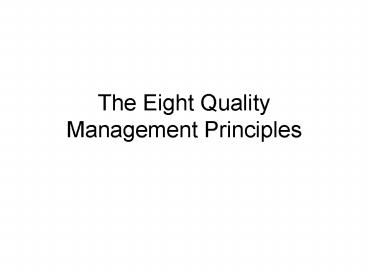The Eight Quality Management Principles - PowerPoint PPT Presentation
1 / 9
Title:
The Eight Quality Management Principles
Description:
... suppliers, local communities and society at large. ... recognize people's contributions. Promote open and honest communication. ... communications. ... – PowerPoint PPT presentation
Number of Views:425
Avg rating:3.0/5.0
Title: The Eight Quality Management Principles
1
The Eight Quality Management Principles
2
Principle 1 Customer-Focused Organization
- "Organizations depend on their customers and
therefore should understand current and future
customer needs, meet customer requirements and
strive to exceed customer expectations". - Steps in application of this principle are ...
- Understand customer needs and expectations for
products, delivery, price, dependability, etc. - Ensure a balanced approach among customers and
other stake holders (owners, people, suppliers,
local communities and society at large) needs and
expectations. - Communicate these needs and expectations
throughout the organization. - Measure customer satisfaction act on results,
and - Manage customer relationships.
3
Principle 2 - Leadership
- "Leaders establish unity of purpose and direction
of the organization. They should create and
maintain the internal environment in which people
can become fully involved in achieving the
organizations objectives." - Steps in application of this principle are ...
- Be proactive and lead by example.
- Understand and respond to changes in the external
environment. - Consider the needs of all stake holders including
customers, owners, people, suppliers, local
communities and society at large. - Establish a clear vision of the organizations
future. - Establish shared values and ethical role models
at all levels of the organization. - Build trust and eliminate fear.
- Provide people with the required resources and
freedom to act with responsibility and
accountability. - Inspire, encourage and recognize people's
contributions. - Promote open and honest communication.
- Educate, train and coach people.
- Set challenging goals and targets, and
- Implement a strategy to achieve these goals and
targets.
4
Principle 3 Involvement of People
- "People at all levels are the essence of an
organization and their full involvement enables
their abilities to be used for the organizations
benefit". - Steps in application of this principle are...
- Accept ownership and responsibility to solve
problems. - Actively seek opportunities to make improvements,
and enhance competencies, knowledge and
experience. - Freely share knowledge experience in teams.
- Focus on the creation of value for customers.
- Be innovative in furthering the organizations
objectives. - Improve the way of representing the organization
to customers, local communities and society at
large. - Help people derive satisfaction from their work,
and - Make people enthusiastic and proud to be part of
the organization.
5
Principle 4 - Process Approach
- "A desired result is achieved more efficiently
when related resources and activities are managed
as a process." - Steps in application of this principle are ...
- Define the process to achieve the desired result.
- Identify and measure the inputs and outputs of
the process. - Identify the interfaces of the process with the
functions of the organization. - Evaluate possible risks, consequences and impacts
of processes on customers, suppliers and other
stake holders of the process. - Establish clear responsibility, authority, and
accountability for managing the process. - Identify internal and external customers,
suppliers and other stake holders of the process,
and - When designing processes, consider process steps,
activities, flows, control measures, training
needs, equipment, methods, information, materials
and other resources to achieve the desired
result.
6
Principle 5 - System Approach to Management
- "Identifying, understanding and managing a system
of interrelated processes for a given objective
improves the organizations effectiveness and
efficiency." - Steps in application of this principle are ...
- Define the system by identifying or developing
the processes that affect a given objective. - Structure the system to achieve the objective in
the most efficient way. - Understand the interdependencies among the
processes of the system. - Continually improve the system through
measurement and evaluation, and - Estimate the resource requirements and establish
resource constraints prior to action.
7
Principle 6 Continual Improvement
- "Continual improvement should be a permanent
objective of the organization." - Steps in application of this principle are ...
- Make continual improvement of products, processes
and systems an objective for every individual in
the organization. - Apply the basic improvement concepts of
incremental improvement and breakthrough
improvement. - Use periodic assessments against established
criteria of excellence to identify areas for
potential improvement. - Continually improve the efficiency and
effectiveness of all processes. - Promote prevention based activities.
- Provide every member of the organization with
appropriate education and training, on the
methods and tools of continual improvement such
as the Plan-Do-Check-Act cycle , problem solving
, process re-engineering, and process innovation.
- Establish measures and goals to guide and track
improvements, and - Recognize improvements.
8
Principle 7 - Factual Approach to Decision Making
- "Effective decisions are based on the analysis of
data and information." - Steps in application of this principle are ...
- Take measurements and collect data and
information relevant to the objective. - Ensure that the data and information are
sufficiently accurate, reliable and accessible. - Analyze the data and information using valid
methods. - Understand the value of appropriate statistical
techniques, and - Make decisions and take action based on the
results of logical analysis balanced with
experience and intuition.
9
Principle 8 - Mutually Beneficial Supplier
Relationships
- "An organization and its suppliers are
interdependent, and a mutually beneficial
relationship enhances the ability of both to
create value." - Steps in application of this principle are ...
- Identify and select key suppliers.
- Establish supplier relationships that balance
short-term gains with long-term considerations
for the organization and society at large. - Create clear and open communications.
- Initiate joint development and improvement of
products and processes. - Jointly establish a clear understanding of
customers' needs. - Share information and future plans, and
- Recognize supplier improvements and achievements.































